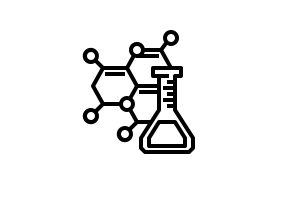Visible-Light Photocatalytic Reduction of CO2 to Formic Acid with a Ru Catalyst Supported by N,N’- Bis(diphenylphosphino)-2,6-diaminopyridine Ligands: Difference between revisions
 publication
publication
| About |
|---|
No edit summary |
m auto-generated |
||
| Line 5: | Line 5: | ||
===Abstract=== | ===Abstract=== | ||
====Summary==== | ====Summary==== | ||
A photochemical reduction of CO<sub>2</sub> to formic acid was shown using the ruthenium pincer complexes {{#moleculelink:|link=RQVVTEHURKEOIA-UHFFFAOYSA-M|image=false|width=300|height=200}} and {{#moleculelink:|link=XNTONGVEYKVCNE-UHFFFAOYSA-M|image=false|width=300|height=200}} as catalyst in combination with the ruthenium-based photosensitizer {{#moleculelink:|link=KLDYQWXVZLHTKT-UHFFFAOYSA-N|image=false|width=300|height=200}}. Turnover numbers (TONs) of 380 for formic acid were reached in dimethylformamide with complex {{#moleculelink:|link=XNTONGVEYKVCNE-UHFFFAOYSA-M|image=false|width=300|height=200}}. The experiments were conducted under visible-light irradiation (λ = 405 nm) using TEOA as sacrificial electron donor (see section SEDs below). | A photochemical reduction of CO<sub>2</sub> to formic acid was shown using the ruthenium pincer complexes {{#moleculelink: |link=RQVVTEHURKEOIA-UHFFFAOYSA-M|image=false|width=300|height=200}} and {{#moleculelink:|link=XNTONGVEYKVCNE-UHFFFAOYSA-M|image=false|width=300|height=200}} as catalyst in combination with the ruthenium-based photosensitizer {{#moleculelink:|link=KLDYQWXVZLHTKT-UHFFFAOYSA-N|image=false|width=300|height=200}}. Turnover numbers (TONs) of 380 for formic acid were reached in dimethylformamide with complex {{#moleculelink:|link=XNTONGVEYKVCNE-UHFFFAOYSA-M|image=false|width=300|height=200}}. The experiments were conducted under visible-light irradiation (λ = 405 nm) using TEOA as sacrificial electron donor (see section SEDs below). | ||
====Advances and special progress==== | ====Advances and special progress==== | ||
The authors report a novel molecular architecture for a ruthenium photocatalyst active in the reduction of CO<sub>2</sub> to formic acid, displaying competitive TONs and quantum yields up to 14%. | The authors report a novel molecular architecture for a ruthenium photocatalyst active in the reduction of CO<sub>2</sub> to formic acid, displaying competitive TONs and quantum yields up to 14%. | ||
Revision as of 10:20, 29 January 2024
|
This page about a publication or dataset does not currently include an investigation. Please add any experiments detailed in the publication or performed to obtain this dataset.
|
More investigations in the SI
Abstract
Summary
A photochemical reduction of CO2 to formic acid was shown using the ruthenium pincer complexes Ru(py)-(HNdpp)2(CO)2Cl and Ru(py)-(MeNdpp)2(CO)2Cl as catalyst in combination with the ruthenium-based photosensitizer [Ru(bpy)3][PF6]. Turnover numbers (TONs) of 380 for formic acid were reached in dimethylformamide with complex Ru(py)-(MeNdpp)2(CO)2Cl. The experiments were conducted under visible-light irradiation (λ = 405 nm) using TEOA as sacrificial electron donor (see section SEDs below).
Advances and special progress
The authors report a novel molecular architecture for a ruthenium photocatalyst active in the reduction of CO2 to formic acid, displaying competitive TONs and quantum yields up to 14%.
Additional remarks
Content of the published article in detail
The article contains results for the reduction of CO2 to formic acid under visible-light catalysis using ruthenium complexes as catalysts. The catalytic system performs best (referring to the TON of formic acid production) with complex Ru(py)-(MeNdpp)2(CO)2Cl in dimethylformamide.
Catalyst
Photosensitizer
Investigation
| cat | cat conc [µM] | PS | PS conc [mM] | e-D | solvent A | . | λexc [nm] | . | TON H2 | TON HCOOH | . | |
|---|---|---|---|---|---|---|---|---|---|---|---|---|
| 1. | 25 | 0.025 | 405 | 380 | ||||||||
| 2. | 50 | 0.05 | 405 | 210 | ||||||||
| 3. | 100 | 0.1 | 405 | 57.5 | 363 | |||||||
| 4. | 500 | 1 | 405 | 14 | 162 | |||||||
| 5. | 1000 | 1 | 405 | 13.3 | 90.5 | |||||||
| 6. | 500 | 1 | 405 | 14 | 70.5 | |||||||
| 7. | 1000 | 1 | 405 | 12 | 44.5 | |||||||
| 8. | 2000 | 1 | 405 | 9.3 | 41.5 |

Sacrificial electron donor
In this study, the experiments were done with the sacrificial electron donors TEOA (100507).
Additives
In this study, no additives were tested.

Investigations
- Table 1 (Molecular process, Photocatalytic CO2 conversion experiments)

